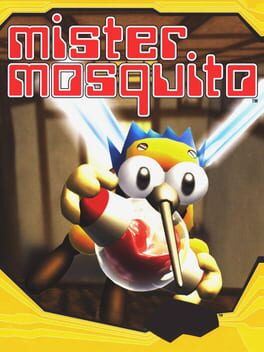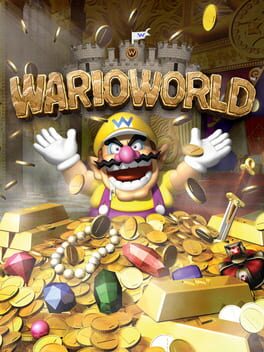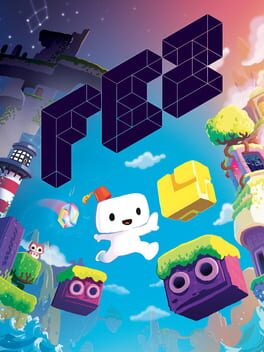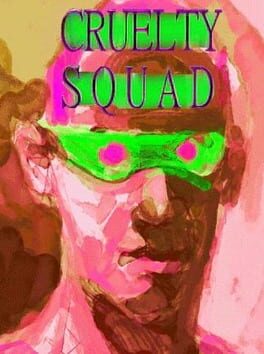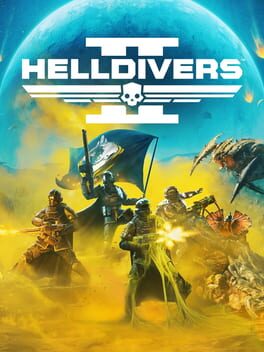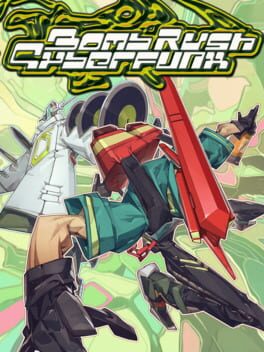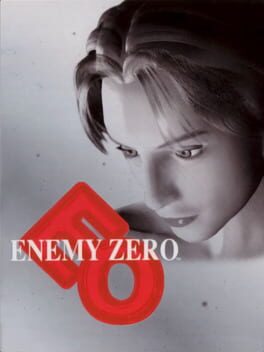BaconFace
BACKER
286 Reviews liked by BaconFace
Mister Mosquito
2001
Wario World
2003
Fez
2012
Stranglehold
2007
Falls victim of the early-new gen console control setting abomination, trust me, you have better dexterity by putting yourself to knitting under influence than doing a dive-while-shooting here and guess what? I've beaten this mother like 5 times. It's a sugar rushed Max Payne with a claustrophobic alcohol-poisoned juggling of eccentric and absurdly overboard gunplay, boss fights that sponge-bullets like it's feathers and duct-taped to mindless power meters for a redbull fuelled assembly line of henchmen like a ludicrous weaponholic wetdream. I've round up all my ridiculously demanding power-meter just to shoot dudes in the groin simply for the hilariously dramatic death animation, and the game expects you to multitask the humanely possible mayhem to re-fill these wonders. You must drop chandeliers WHILE moving WHILE jumping on air, and that's so absurdly convoluted for a newfound player but it sounds exactly like a John Woo'ism alright. The Killer is my go-to mindless testosterone action film by default, but this is a childish catnip for fever-dreamy exaggeration in the best, evidently broken and absurdly overkill fashion. Guilty pleasure.
Cruelty Squad
2021
Helldivers 2
2024
3D shooters are a genre long and particularly afflicted with 'just so' game design; Half-Life popularized a reload mechanic where you tap a button and wait to have your gun refilled from a pool, and this became a defacto standard for no particular reason over not having reloading, or reloading that actually has gun magazine management, or dozens of other one off systems meant to represent a games ethos. Halo introduced a two-weapon system that, along side a nuanced weapon selection forced you to always accept a trade off, games without nuanced weapon selections copied it wholesale, usually resulting in defacto one weapon system because you really need to carry the M16 at all times to get anything done. Halo Infinite in turn has a sprint button with so little effect that you need a stopwatch to tell if it makes you faster- because Halo doesn't benefit from a sprint mechanic but Shooters Have Sprint. Helldivers is perhaps the only studio published 3D shooter in half a decade if not more where there is no 'just so' game design, from meat and potato mechanics like your gun's recoil being semi-deterministic to help you avoid the regular concern of friendly fire, and your gun being loaded from a small pool of disposable magazines, to fun details like running out of spawns but completing the mission objective still constituting a victory.
Tails Adventure
1995
An overlooked Sonic spin-off. Tail's Adventure is somewhat of a Metroidvania where it had great ideas but fell flat due to the hardware it's on. The screen crunch and jankiness did not help this game at all. I wish Sega expanded on this idea and tried again on better hardware because the idea of a Tails themed metroidvania where you get to use his gadgets to explore is excellent on paper.
Banjo-Kazooie
1998
Looking back on the games I played over the course of my childhood, I've noticed that some of my most memorable gaming expirences came from Rare. Before I discovered Banjo-Kazooie, I played and beat the GBA port of Donkey Kong Country 2 and the DS remake of Diddy Kong Racing, but out of those two games I found Diddy Kong Racing DS to be much more interesting. I frequently looked up information online on how to unlock everything that the game had to offer. Apon doing so, I eventually discovered that there was a whole other version of the game that came before it with a few characters that weren't in the DS version. This is how I discovered the existence of Banjo. It wasn't until I connected my Xbox 360 to the internet for the first time a few years later that I would rediscover Banjo-Kazooie and download the demos of this game and its sequel Tooie. Not long after, I was able to purchase both of them and enjoy them to my heart's content. The Banjo-Kazooie games quickly became some of my all-time favorites, leading me into developing a fascination for the developers that made them. I've even attempted speedrunning this game on the 360 version multiple times with my best time being around 5 hours. Having just finished another playthrough of this masterpiece, I will say this is easily Rare's best collect-a-thon and one of the best 3d platformers ever made.
There are a lot of positive things to say about Banjo-Kazooie. The graphics are nice, the characters are funny & memorable, the worlds are enjoyable to explore, and the size of said worlds are just right. One big issue with some of the games that came after this one such as Donkey Kong 64 & Banjo-Tooie are that the worlds are just too damn big and require a lot of backtracking. WIth Banjo-Kazooie, all the objectives & goodies are scattered throughout the levels in a way that isn't intrusive. The only exception being one jiggy you'll have to backtrack for in the middle part of the game, but unless you're aiming for 100% completion it is totally optional.
As far as negatives go, the controls can be a little confusing. It could be since my last playthrough was a couple years ago, but I had some trouble remembering the imputs for a few moves or just accidently doing the wrong thing. It was never something I thought about until I played this version but that's probably because of the obtuse design of the controller. The other issue is something that the 360 version fixes which involves having to recollect the Jinjos and musical notes if you died. It can be very aggrivating to go through the process of getting them all again, especially if you die in any of the later worlds. However, the reason this issue exists is because of hardware limitations so its somewhat excusable.
Banjo-Kazooie is Rare's most iconic IP and rightfully so. Its tight level design, beautiful worlds, and memorable cast cement this game as the best 3d platformer on the N64. Between Banjo-Kazooie & Mario 64, I'd say the bear & bird duo gave the Italian plumber a run for his money.
There are a lot of positive things to say about Banjo-Kazooie. The graphics are nice, the characters are funny & memorable, the worlds are enjoyable to explore, and the size of said worlds are just right. One big issue with some of the games that came after this one such as Donkey Kong 64 & Banjo-Tooie are that the worlds are just too damn big and require a lot of backtracking. WIth Banjo-Kazooie, all the objectives & goodies are scattered throughout the levels in a way that isn't intrusive. The only exception being one jiggy you'll have to backtrack for in the middle part of the game, but unless you're aiming for 100% completion it is totally optional.
As far as negatives go, the controls can be a little confusing. It could be since my last playthrough was a couple years ago, but I had some trouble remembering the imputs for a few moves or just accidently doing the wrong thing. It was never something I thought about until I played this version but that's probably because of the obtuse design of the controller. The other issue is something that the 360 version fixes which involves having to recollect the Jinjos and musical notes if you died. It can be very aggrivating to go through the process of getting them all again, especially if you die in any of the later worlds. However, the reason this issue exists is because of hardware limitations so its somewhat excusable.
Banjo-Kazooie is Rare's most iconic IP and rightfully so. Its tight level design, beautiful worlds, and memorable cast cement this game as the best 3d platformer on the N64. Between Banjo-Kazooie & Mario 64, I'd say the bear & bird duo gave the Italian plumber a run for his money.
Metroid
1986
I am going to be honest and say that the original Metroid for NES, is not great. Its feels, even compared to games of its time, very flawed. Something that I am mostly drawn to say due to how it feels as if Nintendo wanted to do so much with the game, wasn't able to due to the NES hardware, and still put it out in a lackluster state. I didn't find the game very intriguing, and just kept finding flaws and issues around almost every corner. Due to this I will not be finishing Metroid, and will instead play the remaster for gba. With all that said however, I do respect what this game started, it was a building block of the metriod-vania genres (duh, its in the name), and I can understand where this game was able to influence in that manner.
Bomb Rush Cyberfunk
2023
Love the look, like the music, don't like most else. It's movement mechanics feel restricting in a way tony hawk didn't 20 years ago, you only have 3 tricks in big open void levels with grinding only specifically on rails. it's way to easy and stale to bust out a million point combo. Combine that with the repetitive combat you have to do occasionally and I'm done after 2ish hours trying to play.
At least it's better done gameplay than jet set radio but only just
Honestly just play tony hawk.
5/10
At least it's better done gameplay than jet set radio but only just
Honestly just play tony hawk.
5/10
Enemy Zero
1996
While not my personal favorite of Eno's works, I would say that it's without a doubt his most consistently solid game. It's occasionally slow at points, but no game since has made me feel this apprehensive, even on repeat playthroughs. No amount of replays dulls this game's terrifying edge, and considering this came out in 1996, it's a real shame that basically 0 survival horror games since have even come close to being this legitimately anxiety inducing.
Enemy Zero
1996
Enemy Zero
1996
Memory presented as a delicate and fallible abstraction, defining our sentience, identity, and humanity. What keeps us as a species seeking survival aside from the bare minimum of self-preservation that separates the human condition to other species, and what is worth surviving and existing? Kenji Eno's space horror art-house game plays on his pet themes seen in D2 and set a preliminary thesis in Enemy Zero to great success a majority of its time. It plays like an interactive film hybrid of being a first person survival game mixed point-and-click adventure game with grounded puzzles that propel the story forward. Its inspiration is worn heavily on its sleeve borrowing a page from both Blade Runner to Alien. Without giving too much away, it manages to maintain its own identity and keeps from being contrived by expanding on certain thematic elements of both that aren't simple retreads.
Enemy Zero's protagonist stars Eno's Digital actress named 'Laura', a concept he heavily believed would be the future of entertainment and was thinking in the same vein as William Gibson's Idoru centering around a future with digital celebrities. Within the same year, the world was introduced to Tomb Raider and what we would soon see was the first digital celebrity being featured on Playboy magazine and spear-heading campaigns for Pepsi, cars, and other big brands.
The voice actor Jill Cunniff of the band Luscious Jackson plays Laura convincingly and I found myself invested in Laura's care for others and her plight. The concept of a digital actor ties well to its theme of sentience and whether a soul is defined by self-preservation and memory; his digital actress acts almost as a meta commentary on video games as a whole - the personification the player gives to an abstract 16 bit character or 32-bit blocky abstraction. We give likeness to what we want to identify as human or sentient, and in the case of Laura, what defines her humanity, or further asking what defines the human condition: the capacity for empathy towards the appreciation of abstractions; preservation of memory; whether we are always defined by painful memories and if they have merit to hold on to; caring for the other; and arguably the biggest theme, yearning for connection. Thematically the gameplay ties into these ideas, particularly the quasi-fps section.
Sensory experience is an integral piece of Enemy Zero and at the forefront of Eno's thematic obsessions of how humans interact with their environment, specifically auditory and visual. During the fps portions of the game, you navigate from dimly-lit sterile corridors completely alone, with only a ear-piece beacon and charge pulse-gun holding limited charges. You can't see the enemy, yet only hear them from 3-tonal pings indicating if its in front, to the side, or behind the player that intensifies the closer the enemy approaches until it's an unbearable crescendo followed by a harrowing screech as it closes-in. On top of this, the only weapon you have has to be timed perfectly to be used and can only fire within close-range. It is some of the most nerve-wracking moments I've ever experienced and is highly effective in not just engrossing the player, but also making confrontations daunting and forcing the player to become hyper aware of their environment. Without spoiling anything, it ties back to its humanist themes of experience perfectly and connects something not seen typically in games - the appreciation of silence, of experiencing the world through sounds and how a simple sound can instantly change our mood or yearn for a familiar voice we may never hear again.
Kenji Eno viewed games as little capsulized sensory experiences and his experimentation with sound being a core mechanic connecting to sight and memory are unlike anything in a game. Real Sound would be his most experimental in pushing this concept to its most extreme while D2 built on the foundation of both former titles. There are minute-sized details in Enemy Zero that I'll hold with me whenever I look back on this game: from the load/save mechanic acting as Laura's inner monologue and journal entries to Laura trying to grab holographic butterflies in vain, and Laura's reflection trapped in a projected window as she stares pensively towards space. The game isn't perfect and at times suffers from outdated design as a product of its time, yet these are small blemishes to the entire scope of its delivery. Eno was ahead of his time in trying to emulate an interactive film and for the most part is successful. It has near-perfect pacing in delivering its story and does not overstay its welcome. After finishing Enemy Zero, I wanted to immerse myself again in that environment and listen to its characters wax poetic and pontificate on the memories they live for. In turn, it had me thinking introspectively on the memories I hold onto; both painful and embarrassing, yet equally important in defining the self, and reminding me what I'm reaching towards in my own growth. These are the memories that I hope will never fade away, and ultimately keep me alive. To me, this is worth living for alone, and is worth everything.
Enemy Zero's protagonist stars Eno's Digital actress named 'Laura', a concept he heavily believed would be the future of entertainment and was thinking in the same vein as William Gibson's Idoru centering around a future with digital celebrities. Within the same year, the world was introduced to Tomb Raider and what we would soon see was the first digital celebrity being featured on Playboy magazine and spear-heading campaigns for Pepsi, cars, and other big brands.
The voice actor Jill Cunniff of the band Luscious Jackson plays Laura convincingly and I found myself invested in Laura's care for others and her plight. The concept of a digital actor ties well to its theme of sentience and whether a soul is defined by self-preservation and memory; his digital actress acts almost as a meta commentary on video games as a whole - the personification the player gives to an abstract 16 bit character or 32-bit blocky abstraction. We give likeness to what we want to identify as human or sentient, and in the case of Laura, what defines her humanity, or further asking what defines the human condition: the capacity for empathy towards the appreciation of abstractions; preservation of memory; whether we are always defined by painful memories and if they have merit to hold on to; caring for the other; and arguably the biggest theme, yearning for connection. Thematically the gameplay ties into these ideas, particularly the quasi-fps section.
Sensory experience is an integral piece of Enemy Zero and at the forefront of Eno's thematic obsessions of how humans interact with their environment, specifically auditory and visual. During the fps portions of the game, you navigate from dimly-lit sterile corridors completely alone, with only a ear-piece beacon and charge pulse-gun holding limited charges. You can't see the enemy, yet only hear them from 3-tonal pings indicating if its in front, to the side, or behind the player that intensifies the closer the enemy approaches until it's an unbearable crescendo followed by a harrowing screech as it closes-in. On top of this, the only weapon you have has to be timed perfectly to be used and can only fire within close-range. It is some of the most nerve-wracking moments I've ever experienced and is highly effective in not just engrossing the player, but also making confrontations daunting and forcing the player to become hyper aware of their environment. Without spoiling anything, it ties back to its humanist themes of experience perfectly and connects something not seen typically in games - the appreciation of silence, of experiencing the world through sounds and how a simple sound can instantly change our mood or yearn for a familiar voice we may never hear again.
Kenji Eno viewed games as little capsulized sensory experiences and his experimentation with sound being a core mechanic connecting to sight and memory are unlike anything in a game. Real Sound would be his most experimental in pushing this concept to its most extreme while D2 built on the foundation of both former titles. There are minute-sized details in Enemy Zero that I'll hold with me whenever I look back on this game: from the load/save mechanic acting as Laura's inner monologue and journal entries to Laura trying to grab holographic butterflies in vain, and Laura's reflection trapped in a projected window as she stares pensively towards space. The game isn't perfect and at times suffers from outdated design as a product of its time, yet these are small blemishes to the entire scope of its delivery. Eno was ahead of his time in trying to emulate an interactive film and for the most part is successful. It has near-perfect pacing in delivering its story and does not overstay its welcome. After finishing Enemy Zero, I wanted to immerse myself again in that environment and listen to its characters wax poetic and pontificate on the memories they live for. In turn, it had me thinking introspectively on the memories I hold onto; both painful and embarrassing, yet equally important in defining the self, and reminding me what I'm reaching towards in my own growth. These are the memories that I hope will never fade away, and ultimately keep me alive. To me, this is worth living for alone, and is worth everything.
